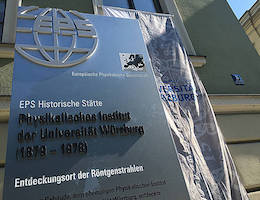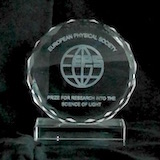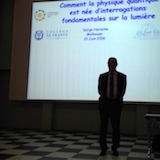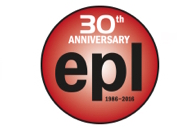July 2016 | Facts and Info from the European Physical Society | e-EPS
Is this email not displaying correctly?
View it in your browser.


Editorial – BREXIT: What’s next?
What a summer! After the Brexit referendum of June 23 the international events rolled in at an incredible pace: killing of police officers on July 7 in Dallas (TX-USA) followed by another one in Baton Rouge (LA_USA) on July 17 (without mentioning Orlando (FL-USA) mass shooting a month before), the truck attack in Nice, FR on July 14, the Turkish military coup on July 15, etc., and this is only a small ...
[read more]

EPS awards former Institute of Physics “Historic Site”
Great honour for the Würzburg science: The European Physical Society (EPS) has distinguished the institute where in 1895 Wilhelm Conrad Röntgen discovered the radiation later named after him. The building is now the third “Historic Site” of the EPS in Germany.
[read more]

Call for the Research into the Science of Light Prize 2017
The Quantum Electronics and Optics Division (QEOD) of the European Physical Society is presently soliciting nominations for their biennial prize Research into the Science of Light. Details of the required material to provide are given below.
[read more]

Statement by Christophe Rossel, President of the EPS, after UK’s decision to leave the EU
Mulhouse, 24 June 2016 – The European Physical Society (EPS) regrets the outcome of the vote by the British people and their decision to leave the ...
[read more]

Nobel Prize Serge Haroche in Mulhouse for a “conférence exceptionnelle”
The Université de Haute-Alsace in Mulhouse (France) received the visit of the French Nobel Laureate Serge Haroche on 10 June 2016. During his visit, Prof. Haroche gave a lecture as the ...
[read more]
ALMA Observes Most Distant Oxygen Ever
A team of astronomers has used the Atacama Large Millimeter/submillimeter Array (ALMA) to detect glowing oxygen in a distant galaxy seen just 700 million years after the Big Bang. This is the most distant galaxy in which oxygen has ever been unambiguously detected, and it is most likely being ionised by powerful radiation from young giant stars.
[read more]
CERN – Statement about UK referendum on the EU
Many people have expressed their concerns about the consequences of the 23 June vote in the UK for CERN, and for the UK’s relationship with CERN. CERN is an intergovernmental organisation subject to its own treaty. We are not part of the European Union, and several of our Member ...
[read more]
EPS Young Minds and the IONS Naples 2016 meeting
The Naples Young Minds (YM) EPS section hosted the IONS 2016 meeting, held in Naples from 6th to 8th July 2016. IONS the International OSA Network of Students, was started in 2007 by the Optical Society (OSA). The network is open to all young scientists working in the fields of optics and photonic.
[read more]
Creation of an Expert Group on Altmetrics and Contribution of the EPS
DG Research and Innovation has established an Expert Group on Altmetrics which will conduct its work over the whole of 2016. The Expert Group will, among other: Categorise and review different ...
[read more]
IUPAC is naming the four new elements nihonium, moscovium, tennessine, and oganesson
Following earlier reports that the claims for discovery of these elements have been fulfilled, the discoverers have been invited ...
[read more]
NASA’s Juno Spacecraft in Orbit Around Mighty Jupiter
After an almost five-year journey to the solar system’s largest planet, NASA’s Juno spacecraft successfully entered Jupiter’s orbit during a 35-minute engine burn. Confirmation that the burn had completed was received on Earth at 8:53 p.m. PDT (11:53 p.m. EDT) Monday, July 4.
[read more]
Hommage to José Mariano Gago – Science and Europe
On June 29, a conference in honour of the life and legacy ...
[read more]
EPS Executive & Staff activity for June 2016
The EPS works to support its members. Find below the list of activities of the EPS Executive Committee and staff last month:




